|
BULB LOG 29 --- 17th July 2007
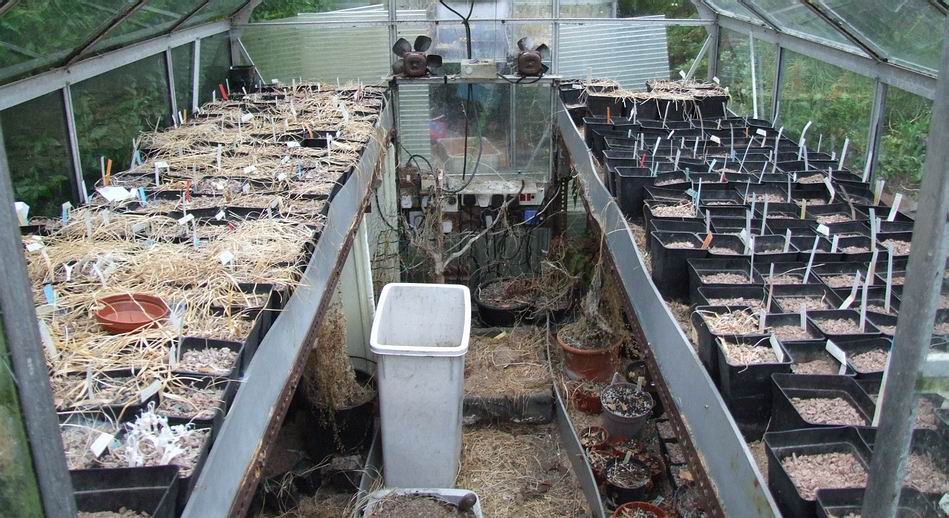
Bulb house 16.07.07
I am getting on with the big re-pot of the bulbs with the hope of getting through them all this year - at least all the pots under glass.
I still believe that you get better results from your bulbs, both in terms of the number of flowers and the increase in bulbs, if you can re-pot every year. Many people tell me that they only re-pot every second year - they say the bulbs do not like being disturbed and they back this up by pointing out to me that the bulbs never flower so well the year after they were re-potted. Well I can agree with that last statement but the reason they give is wrong. The diminished flowering is not to do with the disturbance of re-potting - if the bulbs are dormant how do they know they were disturbed at all? The flowers for next spring are formed at the end of the previous growth cycle - so they have formed and are ripening now. The reason for lack of flowers is that the bulbs were growing for the second year in the same old compost which has a much reduced level of minerals and nutrient.
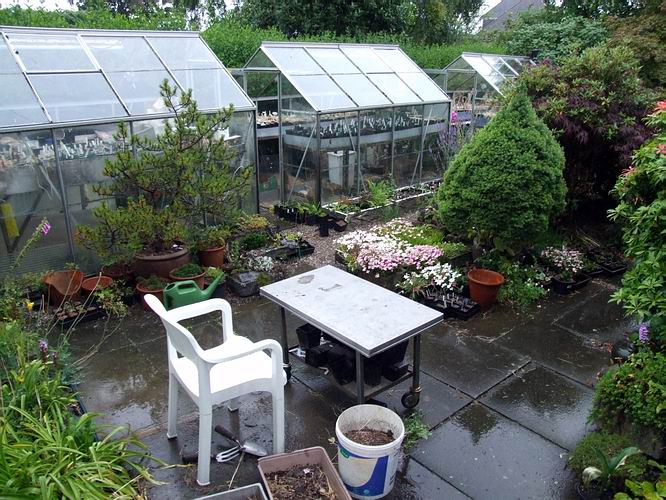
Repotting station
This is Monday morning and I had hoped to be out at my re-potting station working through the pots of bulbs but heavy persistent rain is preventing me so I am making an early start on this week's bulb log. Notice some of the troughs of Rhodohypoxis enjoying the wet summer conditions.
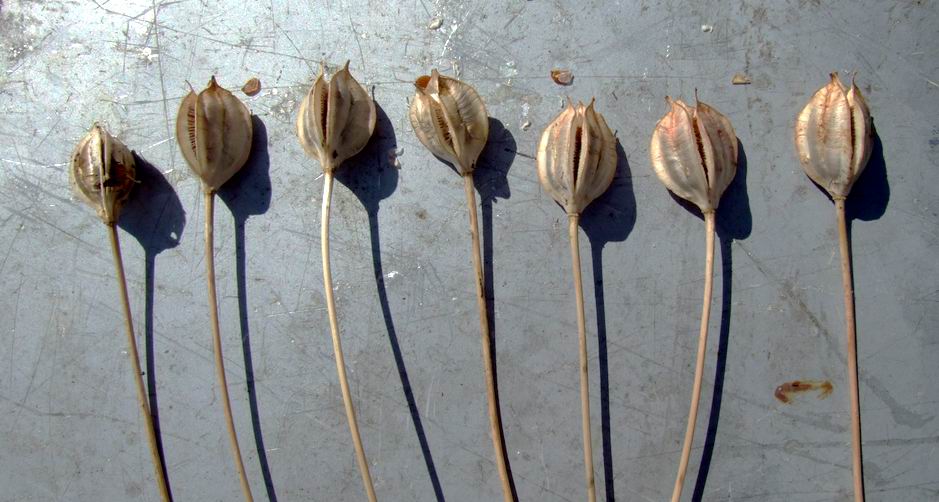
Tulipa urumiensis seed pods
I was speaking about storing seeds last week and I wanted to expand a bit on what I was saying.
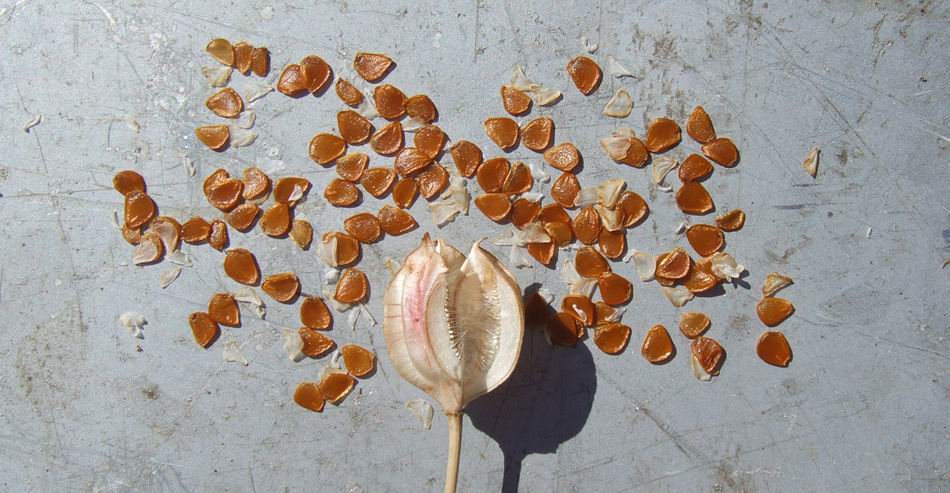
Tulip seeds
There are basically two kinds of bulb seeds. Flat, papery types, like these tulip seeds, are best stored in paper bags in a dry stable temperature - not a fridge as that is too cold and I now suspect that the embryo contained in bulb seeds continues to ripen and form for some time after it appears ripe to us and cold temperatures can arrest that development. Long term storage at low temperatures in seed banks is very effective as long as the seed has been allowed to ripen fully before it is placed into the freezer.

Crocus nudiflorus seeds
The other main seed type is the plump type as found in crocus, narcissus, etc. and these are the types that I mostly store in plastic bags mixed in dry sand. I also store these bags in the bulb shed, which is out of direct sunshine for the summer, before sowing them in the autumn. Storing the different seeds in these ways is the closest way I can find to replicate the conditions they will receive in the wild - that of a warm dry summer, either lying on the surface as in frit type seeds or buried in warm dry soil as in crocus, narcissus etc.
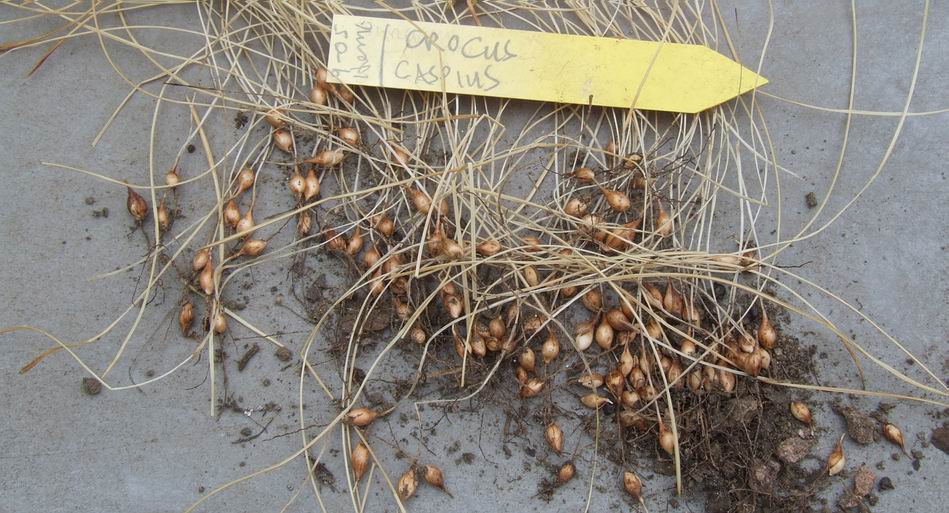
Crocus caspius seedlings
The other factor we must take into account is our expectation of germination rates. In the wild nature's way is to throw hundreds if not thousands of seeds around on the basis that a few at least will survive to carry on the genes and in the wild this works well. But in cultivation when I sow a pot of say 15 seeds I expect 15 to germinate and I am very disappointed if only 6 or 7 germinate, so I have to get the conditions for storing the seeds and sowing the seeds as favourable as possible to match my expectations. Where I am letting bulbs, like erythronium, self sow and naturalise in the garden I am generally very pleased with the rate of seeding but if I counted the number of seed pods and took the average seed count I would be very disappointed with the number of seedlings that actually establish as compared to pot grown ones.
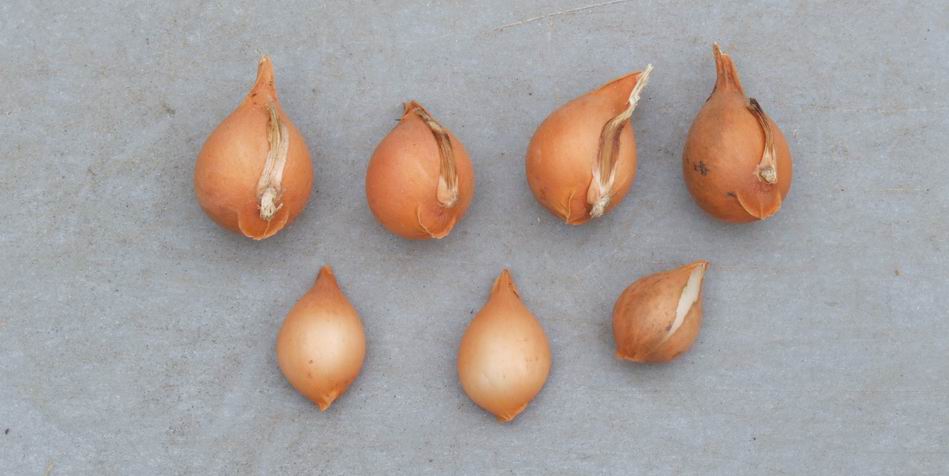
Nice Tulip bulbs
Looking at some of the bulbs I have re-potted the results are mixed and I would say that this has not been a vintage year for growing bulbs in Aberdeen. Look at these nice tulip bulbs/corms (another interesting discussion there) and then look back up the page to the crocus nudiflorus seeds - see the similarity. On the bulbs you can see the small withered remains of the flowering stem and last year's bulb attached to the nice new bulbs, which shows us that the new bulb forms at the side of the stem and the raised keel is where the roots will emerge from this autumn.
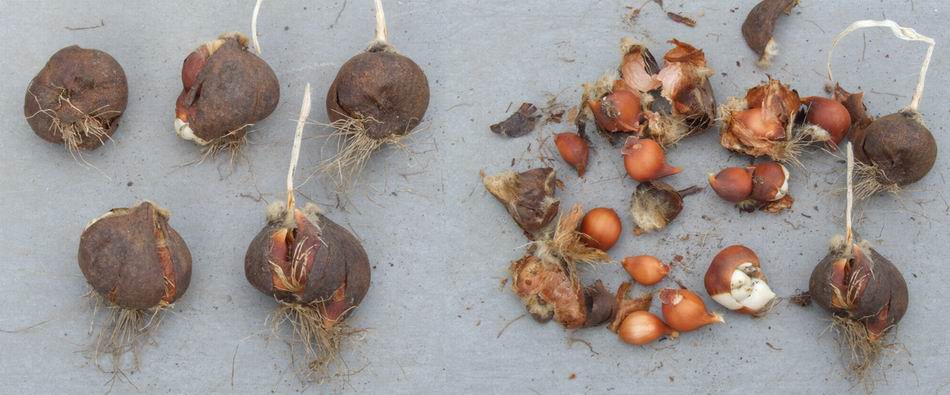
Tulip bulbs
Here is another tulip that was not re-potted last year and when the old tunic is cleaned off you can see that several small bulbs have formed, indicating that I did not water and or feed enough during the last growth period.
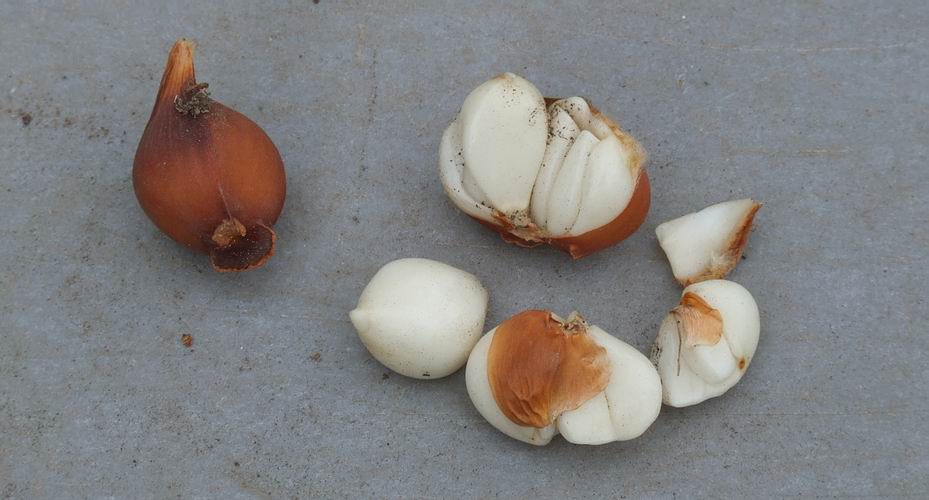
Tulip bulb scales
This splitting up into many small scales or bulblets is a very typical reaction observed in most bulbs that have not been watered enough and I have to admit that I am guilty of not providing enough water this past year.
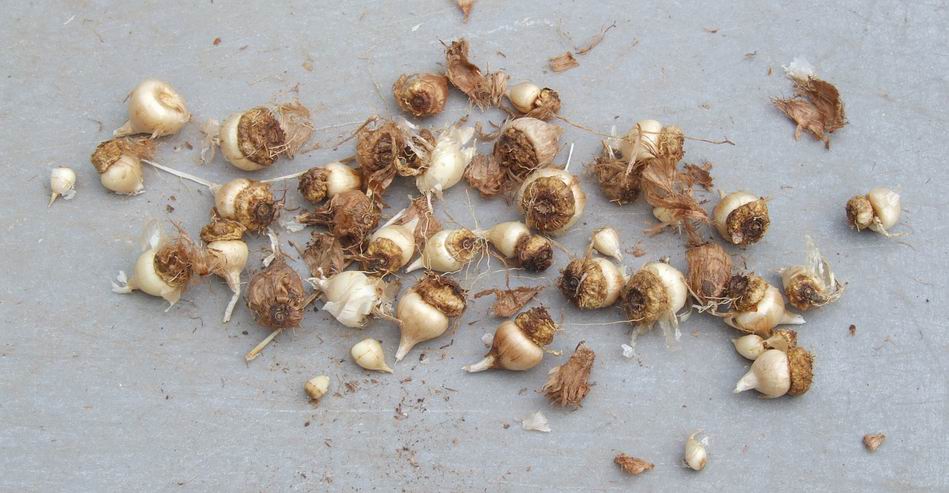
Crocus corms
I showed similar crocus last week and Tony Goode has a post in the forum saying he too has this experience where the old crocus corm does not shrink away to a husk as normal but remains plump at the base of the new corm. Was this the unusual heat we experienced in April forcing the bulbs into a premature dormancy or is it just a lack of watering or is it a combination of both?
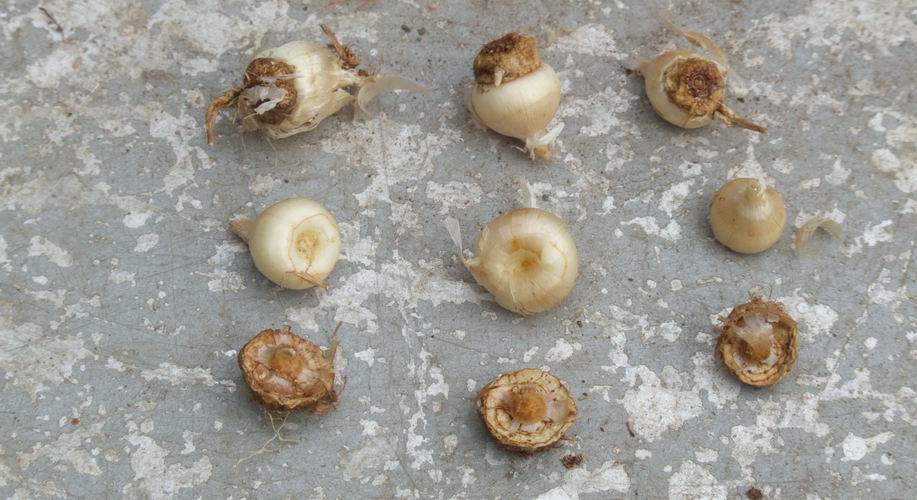
Old corm new corm
The remains of the old corm can always be seen on the base of crocuses and the big question is whether it is best to leave it or remove it when you are re-potting. If it is left there is the worry that it may start to rot when water is applied and that rot can pass on to the new corm. If it is removed does the wound left, albeit very small, leave the corm susceptible to rot entering that way? It is one of the many "damned if you don't damned if you do" situations we are faced with when cultivating bulbs - I tend to remove them if they come away with a gentle twist but if they seem reluctant to come away I leave them.
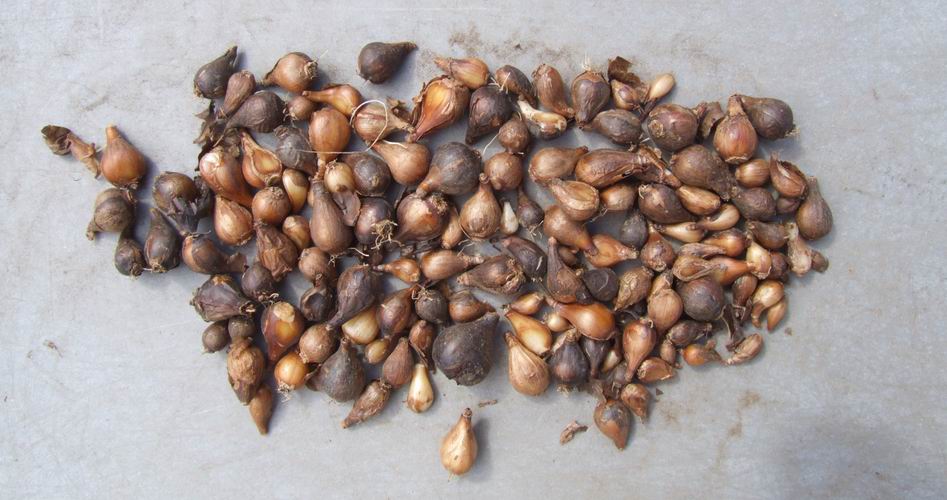
Narcissus bulbs
These Narcissus bulbs are not as big as I would like or normally expect and I have to admit that with my shift over to use all plastic pots last year I have erred on the cautious side and not watered the bulbs enough over the winter and spring when they were growing, especially after the flowers faded. The one good thing is that bulbs can cope much better with being too dry than they can if they are too wet when they can rot away completely. Having been kept too dry I now have a great many more but smaller bulbs of some species to do better with next year. I have used this phenomenon to increase stocks of some narcissus in the past - rather than cutting them up and chipping them just plant them shallow and don't water them too much and instead of providing one offset the bulbs break down into many smaller bulbs which can then be built back up to a good size the next year.
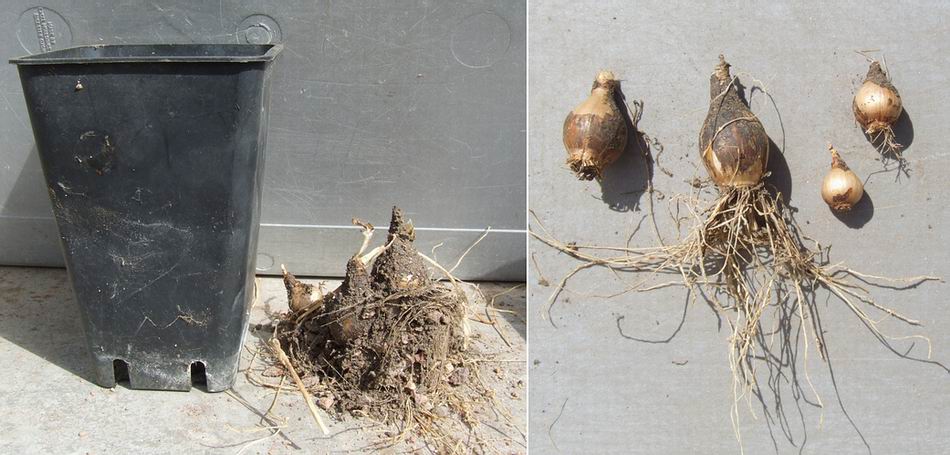
Narcissus triandrus bulbs
Every day is a school day as I continually learn from my mistakes and I am pleased to see that some bulbs have done better with the reduced watering last season. I have always struggled with Narcissus triandrus but these bulbs are excellent and I must surmise that I have previously given them too much water. I will mark the pots up with a red label to remind me not to water them so much as the others. I use blue labels to indicate bulbs with a preference for plenty water, red for ones for those that like it drier and all those without an additional coloured label get the normal amount of watering. I also wanted to show how deep I planted these Narcissus triandrus bulbs: almost at the bottom of the pot, the roots will easily grow up above the level of the bulb or out through the holes into the sand plunge. Different bulbs like different depths and I am slowly learning which ones like to be planted deeply and which like to be about half way down a pot. Now back to the repotting.
^ back to the top ^
|

